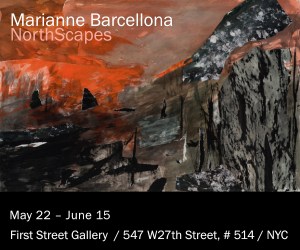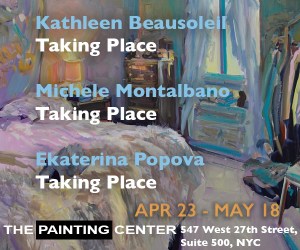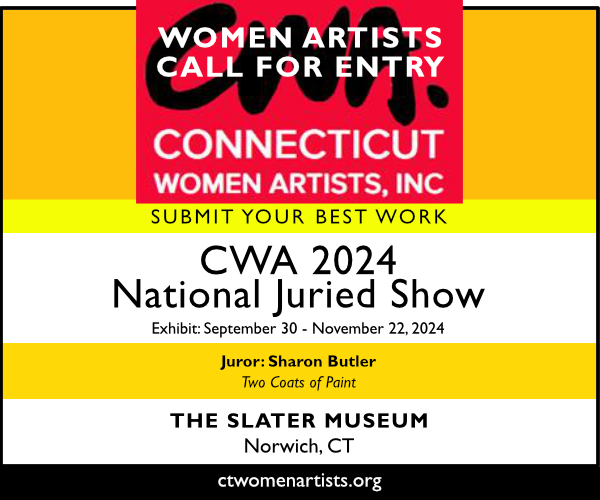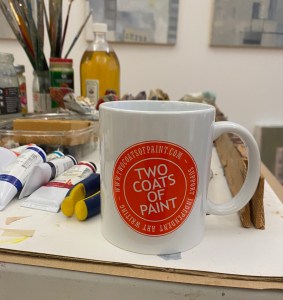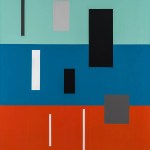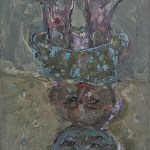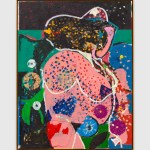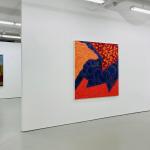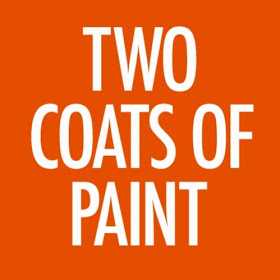
Contributed by�Debbi Kenote /�Staring at a large pin board in Margie Livingston�s Seattle studio, artist�Til Will and I observe a collage of quotes, photos and notes. In the top corner there is a photo of a woman dragging a canvas. One word stands out from the notes: shame. I mull this word over as Livingston introduces her new work -�small prints made from scratched copper surfaces and large dragged paintings. Something about the work feels like evidence; I have the impression that a fingerprint or a shoe indent could be lifted for further clues as to what has happened here. At the same time I am taken by the softness of the images and the subtleties of the colors. In the corner sit makeshift tools – constructions made of cardboard, holding rocks.
Light spills through the windows as Livingston begins to tell us�about her latest body of work, which is centered on�the action of dragging paintings behind her in public with a handmade harness. The work feels performative, and when I inquire she describes a process of making that balances performance and painting. An underpinning of vulnerability surfaces as she describes the connection between publicly dragging�the paintings and the notion�of shame. I find myself thinking of the actual weight of dragging any object, or burden, behind me. She highlights the illogical aspects of feeling shame, while also recognizing her strange newfound power of being able to turn on the emotion. Overall, the peculiar act of dragging a painting behind oneself in public seems to stir something excitingly forbidden and subconscious. I wonder if it�s the harness, or the non-traditional societal role the artist is evoking, or just the absurdity of the gesture. Livingston describes a desire to create space for this �weird activity� in a society that does not embrace outliers. As she explains�her process and her influences�(Adrian Piper, Christian Marclay, Pope.L),�I am�fascinated�by the particularities and uniqueness of Livingston�s practice. Below is�the full transcript of our�conversation.

DEBBI? ?KENOTE:? ?Let�s? ?start? ?with? ?where? ?you? ?grew? ?up.? ?You? ?are? ?from? ?Vancouver, Washington? ?originally?
MARGIE LIVINGSTON: Yes.
DK:? ?And? ?then? ?you? ?went? ?to? ?New? ?York? ?for? ?seven? ?years,? ?and? ?then? ?to? ?Seattle.? ?At? ?what? ?point did? ?you? ?start? ?to? ?get? ?involved? ?in? ?making? ?artwork?
ML: When I moved to Seattle. When I was in New York I was working in advertising. And then when I�moved back here it was a recession, I wasn�t able to get a job, so I thought well, I�ll start painting.
DK:? ?What? ?was? ?the? ?first? ?thing? ?you? ?started? making?
ML: I was painting�really really bad paintings.
DK:? ?Like? ?landscapes?
ML: I won�t even say during this interview how bad [laughs]. But I started taking classes at the community college and I met some people who were taking classes and we asked one artist to do a class with us for a couple years, and that worked out really well. And then I went to graduate school after doing that for about five years.

TIL? ?WILL:? ?How? ?did? ?you? ?find? ?your? ?experience? ?in? ?grad? ?school,? ?at? ?the? ?University? ?of Washington?
ML: It was really exactly what I needed right then, because I don�t have an undergraduate degree, I had this insecurity about if I was doing things right, I didn�t know how to do it, so I got over that, and found a great community.
TW:? ?I? ?think? ?now? ?we? ?should? ?jump? ?into? ?some? ?of? ?the? ?work? ?we�ve? ?been? ?looking? ?at.? ?First? ?and foremost? ?I? ?think? ?we? ?should? ?talk? ?about? ?your? ?most? ?recent? ?work,? ?that? ?has? ?to? ?do? ?with dragging? ?artworks? ?when? ?you? ?take? ?walks.? ?Can? ?you? ?explain? ?how? ?you? ?got? ?to? ?this? ?project?
ML: Sure. The first dragged painting happened because I wanted to do some mending. I had been doing a lot of projects that were traditional women’s handcraft with paint, sewing, and weaving, I thought mending would fit right in. I needed something broken that needed mending. I took a little painting and wrapped a little rope around it and dragged it down the street and came back. I went about as far as you walk a dog, you know that last walk before you go to bed, not that far, just down and back. But when I came back in and I turned the painting over, I realized that that was more interested than any mending I could do. It was somehow really compelling to just have the simplicity of that mark, of the dragging.
DK:? ?How? ?would? ?you? ?say? ?the? ?response? ?has? ?been,? ?to? ?you? ?as? ?an? ?artist? ?dragging? ?a? ?piece? ?on the? ?ground? ?behind? ?you? ?in? ?public?? ?It? ?seems? ?to? ?have? ?some? ?visual? ?weight? ?to? ?it,? ?and? ?you mentioned? ?before? ?the? ?idea? ?of? ?shame.
ML: Well, yeah, there�s two parts of that. When I�m just walking down the street I do feel really embarrassed and it feels shameful. That�s how shame works, you project onto the other person how they are judging you. And so I think �oh there goes some crazy old woman, what�s she doing�� and if I�m out there with someone then it�s fine, then that normalizes it. Or if someone is shooting a video or something, it�s fine. But it�s just that, it�s a walk of shame kind of thing. But then other times people will stop me and ask me questions about what I�m doing, and then it seems I let go of the shame. It�s interesting because shame is a very primitive affect, it goes past logic in your brain. You don�t have access to logic when you�re feeling shamed. It�s been really curious to me have this device, a switch I can just turn on and experience shame. You know it�s not a situation where you would usually have access to that. I think eventually I will rewire my brain to not experience that shame. I mean, I read an interview with Adrian Piper and that is what she said about her experiences with her performances, that walking around with a big gob of gum on her face allowed her to eventually become un-affected by that.
DK:? ?It�s? ?like? ?a? ?more? ?intense? ?version? ?of? ?going? ?through? ?high? ?school? ?or? ?something.
ML: [Laughter] Yeah, exactly.

DK:? ?Do? ?you? ?consider? ?the? ?work? ?you�re? ?making? ?to? ?be? ?performative?
ML: It is performative. I�m at this odd�intersection between painting and performance and video. I have for several years been at the edges of things, with the work I was making before, when I was making sculptures out of paint, it was like a combination of painting and sculpture. And so it feels� natural, I guess is the word, to have the performance and painting butting up against each other.
TW:? ?So,? ?do? ?you? ?think? ?there? ?is? ?a? ?performative? ?aspect? ?to? ?this? ?that? ?you? ?were? ?missing? ?in? ?the poured? ?works? ?that? ?you? ?were? ?doing? ?before?? ?Is? ?that? ?something? ?that? ?you? ?have? ?shared? ?with people? ?in? ?the? ?past,? ?as? ?artwork?? ?The? ?actual? ?act,? ?for? ?instance,? ?of? ?making? ?the? ?grid? ?structure that? ?has? ?paint? ?poured? ?over? ?it?
ML: I�ve done videos of me pouring paint and such, but that never felt like a performance. It always felt like documentation. Whereas this has a different attitude, because… I�m not quite sure why, you could just say the video I�ve made is just a document of me. But it feels different. Maybe because I made the harness, so I�m wearing a specific costume or tool to drag the painting. I don�t really know, but that seems significantly different than the videos I�ve made of me pouring a big sheet of paint.
DK:? ?You? ?talked? ?about? ?walking? ?a? ?dog. Using? ?the? ?harness? ?takes? ?it? ?in a different direction.? ?I? ?think? ?of? ?bondage, of being? ?tied? ?up,? ?or? ?as? ?if? ?the? ?painting? ?is? ?dragging? ?the body,? ?opposed? ?to? ?pulling? ?it? ?behind? ?you? ?with? ?a? ?leash? ?in your? ?hand.
ML: I built the harness based on the harnesses that bodybuilders use, to drag weights. There�s a gym down the street and every once in awhile I�ll see the guys out there with their trainers, dragging 150 pounds down the street on a sled.
DK:? ?Have? ?you? ?ever? ?thought? ?of? ?taking? ?your? ?paintings? ?over? ?there? ?and? ?dragging? ?them?
ML: I don�t think my paintings would support 150 pounds.
DK:? ?That? ?reminds? ?me,? ?can? ?you? ?tell? ?us? ?a? ?little? ?bit? ?about? ?the? ?rocks,? ?how? ?they? ?add? ?to the? ?painting,? ?how? ?you? ?use? ?them?
ML: The rocks increase the weight and the friction on the surface of the painting, so that it wears out and makes holes in the surface. I�ve tried a lot of different kinds of weighting systems. The rocks bounce out of the painting, and it�s kind of hysterical actually. I made a lot of�tools, I�m not sure if you saw them. These are things I use to control where the rocks are and where they�re located. I have other tools I�use with the drawings. The drawing goes�underneath it, so some I drag outside and some I drag here. You can see the ink on my floor.
TW:? ?The? ?drag? ?zone.
DK:? ?Til,? ?how? ?would? ?you? ?describe? ?this? ?tool? ?we�re? ?looking? ?at?
TW:? ?It�s? ?essentially? ?a? ?cardboard? ?structure,? ?with? ?slots? ?cut? ?out? ?for? ?where? ?the? ?rocks? ?live? ?and they�re? ?held? ?into? ?place.
DK:? ?How? ?sacred? ?is? ?this? ?process,? ?Margie?? ?Do? ?the? ?rocks? ?come? ?from? ?a? ?special? ?place? ?or? ?do you? ?arrange? ?them? ?in? ?any? ?special? ?way?? ?Or? ?would? ?you? ?consider? ?it? ?chance?
ML: It�s chance. The rocks come from the street outside, when I�m in the process of doing a series of drawings, walking to the studio my eyes will be scanning the street and I�m thinking �oh look, there�s a good rock.�

DK:? ?What? ?makes? ?a? ?good? ?rock?
ML: If it�s�big and heavy. Chunks of asphalt or worn out concrete are good – they have lots�of texture on the surface. I was curious how the different rocks make different kinds of abrasions on the drawings.
DK:? ?So? ?you? ?move? ?the? ?template? ?around? ?if? ?holes? ?start? ?to? ?appear?
ML: I�ve done a lot of different things. You can see I�ve dragged it from this end and dragged it from that end, you can see a mirror image there. Sometimes I drag it from the side. I do pay attention to the composition, it�s like any kind of mark making.
TW:? ?Can? ?you? ?tell? ?us? ?a? ?little? ?bit? ?about? ?your? ?newest? ?project? ?with? ?the? ?copper? ?plates? ?and where? ?that? ?started?
ML: After dragging the paintings and the drawings, I wanted to do some printmaking and drag the copper plates, so�I signed up for an etching class and started working with those. The first process I tried was kind of like drypoint, dragging the plate raw and printing that. And then I also did some plates where I put hard ground on the surface�and dragged that and etched it. But the hard ground is really tender, so I can�t really drag it very far. It comes off.
TW:? ?Oh? ?I? ?see.
ML: I�m really interested in the durational aspect of the drag, too. I�like�the ones that have been dragged�further with just the plain plate. A friend of mine used to work at a print studio down in Tampa, I think it was, and he showed me how to do viscosity prints, where you can print two colors on the plate at the same time. You rub a thick color into the plate and then wipe it and then roll a looser ink on the top and get this merging of the two kinds of ink on the print.
TW:? Is? ?it? ?important? ?for? ??the? ?viewer? ?to know? ?how? ?the? ?work? ?was? ?made,? ?or? ?is? ?it? ?better? ?if? ?they? ?look? ?at? ?it? ?and? ?think? ?�what? ?happened here?�
ML: Well, yes, it is important for them to know. I�title�the pieces Dragged Painting with Pink, or Dragged Etching, you know, Dragged Plate, or something�Dragged Drawing with Orange. That act of mark making by dragging is important for me, and I want viewers to�know what I�m doing.
DK:? ?How? ?do? ?you? ?think your? ?work? ?fits? ?into? ?the? ?history? ?of? ?painting? ?and? ?performance?? ?Or does? ?it?
ML: Christian Marclay’s Guitar Drag�comes to mind immediately, Pope.L�s crawls through the city, and Yvonne Rainer�s experimental dances, especially Trio A, where she talks about the neutral do-er. I think there�s a real connection with that idea and what I�m doing.
DK:? ?Something? ?about? ?the? ?flattening? ?of? ?it? ?reminds? ?me? ?of? ?Ana? ?Mendieta�s? ?face? ?glass? ?pieces, where? ?she? ?smooshed? ?her? ?face? ?against? ?glass? ?and? ?made? ?distorted? ?images.? ?Her work? ?also? ?has? ?a? ?sense? ?of? ?vulnerability? ?and? ?pushes? ?feminine? ?roles? ?into? ?unexpected? ?places. Do? ?you? ?see? ?any? ?connection? ?there?? ?Thinking? ?also? ?of? ?the? ?vulnerability? ?and? ?the? ?feeling? ?of shame? ?you? ?mentioned? ?while? ?dragging? ?the? ?paintings.? ?Are? ?there? ?feminine? ?perspectives? ?you want? ?people? ?to? ?focus? ?on? ?with? ?the? ?work?
ML: There is a part about being a woman in public that feels important. Because what I�m performing is an odd or peculiar thing. It seems like there�s less and less willingness, on society’s end, of allowing people to be outliers. It�s basically illegal to be homeless, because you camp somewhere and they tell you to move on or they give you a ticket. I don�t consider my work to be directly or literally a protest against this, but I am trying to create space for that kind of weird activity.
TW:? ?It�s? ?especially? ?important? ?now? ?seeing? ?the? ?closure? ?of? ?all?-ages? ?spaces? ?all? ?over? ?and venues,? ?especially? ?in? ?New? ?York,? ?venues? ?for? ?performance? ?art.? ?Let�s? ?go? ?back? ?in? ?time? ?a? ?little with? ?your? ?work,? ?starting? ?with? ?the? ?poured? ?paintings.? ?For? ?those? ?who? ?don�t? ?know,? ?your paintings? ?are? ?essentially? ?made? ?out? ?of? ?paint? ?you? ?pour? ?into? ?sheets,? ?and? ?from? ?that? ?you? ?also make? ?sculptures.? ?The? ?canvases? ?that? ?you? ?made? ?in? ?the? ?last? ?couple? ?years? ?have? ?been? ?a? ?white sheet? ?of? ?paint,? ?stretched? ?around? ?a? ?stretcher.? ?How? ?did? ?you? ?get? ?from? ?the? ?poured paint? ?to? ?this?? ?And? ?the? ?grid? ?structure,? ?is? ?that? ?a? ?newer? ?or? ?older? ?development?
ML: I made objects out of paint for several years, and during that time I was doing a lot of different kinds of making,�using paint as a sculpture material. This [large grid sculpture to the right of us] is a series, maybe the last of that series, of what I called “Falling Grids,” where I set up a grid of string and poured paint over it with multiple layers and hung it on the wall. It can�t support itself, so it collapses on the wall and has that kind of organic softness. At the same time, I was making fake wood out of paint, by rolling the sheets of paint into what looks like a log and cutting against that to make what looks like fake wood grain. I did a lot of collaging. This is layers of paint glued together and cut on that big paper cutter over there, then cut apart again to be little chips of wood or brush stroke type�things. In this one you�re looking at right here, it looks more like brush strokes but I was thinking of them as�wood chips, as if I was�making particle boards. I made�them out of eight-foot sheets of paint. Lots of different kinds of stuff is�always swirling around in the studio.
TW:? ?So? ?were? ?the? ?dragged? ?paintings? ?or? ?drawings? ?first?
ML: The dragged paintings. The first dragged paintings were�paint skin stretched over a structure. Even when I was doing it I would say, oh well, this could really just be a canvas, but because I was in this transition from making objects with paint, I felt compelled to use the paint as canvas.
DK:? ?You? ?mentioned? ?earlier? ?as? ?well? ?that? ?you? ?thought? ?canvas? ?wouldn�t? ?be? ?as? ?durable.
ML: Yes it�s true I think canvas would tear faster.
DK:? ?So? ?how? ?do? ?you? ?go? ?about? ?adding? ?color? ?into? ?them?? ?Is? ?it? ?just? ?a? ?personal? ?mood? ?choice? ?or something? ?more? ?specific?
ML: That�s a good question.

DK:? ?There? ?seems? ?to? ?be? ?a? ?lot? ?of? ?pastel? ?and? ?earthy? ?tones.
ML: Yeah. I guess mood or sensation draws me to the colors. It�s intuition really. No other real logical reason. Every once in awhile I�ll use a color that has personal history. For example,�purple was my mother�s favorite color. And�she always had a yellow kitchen. I did a series of works that were based on a seventeen-pallete Pucci dress. You know I found an image online of the dress and figured out what the seventeen�colors were in it and used that to pour.�I made a big log cabin. To make it, it�s 24� around, I made poured sheets, and I used 80 gallons of paint to make these big ten foot logs,�then I�sent the logs to be cut. And it was in the palette of the Pucci dress.
DK:? ?What? ?was? ?this? ?called?
ML: Stack of Planks.
DK:? ?Wow.
TW:? ?It? ?sounds? ?like? ?you�re? ?in? ?a? ?pretty? ?exciting? ?transitional? ?period? ?right? ?now.? ?Moving? ?from? ?a purely? ?calculated? ?kind? ?of? ?painting? ?or? ?sculpture? ?into? ?a? ?much ?more? ?chance?-based operation.? ?How? ?people? ?are? ?receiving? ?that,? ?how? ?is your? ?community? ?reacting? ?to your new work?
ML: The artists I know are very supportive of what I�m doing. The work isn�t as commercially viable as the big draped paint objects, so we�ll see.
TW:? ?Well? ?that�s? ?a? ?pretty? ?brave? ?thing? ?to? ?be? ?doing? ?at? ?this? ?point? ?in? ?your? ?career,? but ?I? ?feel? ?like? ?it�s probably? ?out? ?of? ?necessity.
ML: Yeah, I was bored. I get restless and like�to move on.
TW:? ?So? ?what�s? ?the ?next? ?project? ?you�re? ?working? ?on?? Does? ?it? ?involve? ?the? ?dragged? ?work?
ML: Mmm. Now I see I�m doing the same thing with the dragging that I was doing making objects. Because I have the video, I have the dragged drawings and the dragged paintings and the dragged prints and I just started the dragged sketchbook. And that�s just all with dragging. It seems that the whole performance part of it could spread out into more tangents but I don�t know what those are at this point.
TW:? ?Is? ?this,? ?the? ?performance? ?aspect? ?at? ?least,? ?something? ?that? ?you? ?see? ?yourself? ?doing? ?in? ?a solitary? ?sense,? ?where? ?you�re? ?not? ?inviting? ?people? ?to? ?come? ?see? ?it,? ?or? ?would? ?you? ?ever? ?do? ?it? ?as an? ?event?
ML: That�s a really good question. I don�t see myself doing it with an audience. I see it more like I�m right on that edge between performance and production. And asking myself that question, you know, where does that production happen? It just doesn�t seem necessary to gather a lot of people to watch me, but I am making a video which is a little closer to that direction. In one video that I shot in here, I�drag�a drawing over a pile of dirt and also a pile of sod. And then the drawing flies off the table on both ends and I pull it up these little ramps. I�m�going to edit it into a continuous loop.
DK:? ?I�m? ?curious,? ?I�d? ?like? ?to? ?hear? ?you? ?talk? ?a? ?little? ?more? ?about? ?the? ?Seattle? ?art? ?scene,? ?how? ?it�s changed? ?over? ?the? ?last? ?decade,? ?what�s? ?going? ?on? ?now,? ?if? ?there�s? ?anything? ?you? ?think? ?people should? ?be? ?looking? ?at.�Do? ?you? ?see? ?any? ?exciting? ?things? ?happening?
ML: The art scene in Seattle is pretty open and supportive, and it�s small enough that you can jump into it and meet people and get connected pretty easily. I�m a member of SOIL, which is an artist run space; I�ve been a member since 2000. The gallery scene here has changed drastically in the last fifteen�years. There was a time when people were all opening galleries, and now they�re all closing because they can�t make it.
DK:? ?The? ?rent? ?is? ?going? ?up? ?or? ?is? ?it? ?the? ?sales?
ML: The rents going up, people can�t afford the spaces. There�are�some artist-run or alternative type spaces that have opened in Georgetown. Tons�of artists are still making work, and it�s just kind of confusing. That�s one of the reasons that I think SOIL is so important, because we provide opportunities for artists to show work that isn�t being shown in other places.
TW:? ?Right.? ?Well?, ?thank? ?you? ?for? ?showing? ?us? ?around? ?your? studio and sharing your ?process.
ML: Of course, thank you for coming!
About the author:�Debbi�Kenote�is an artist, writer and curator currently living in New York City. She received her MFA from Brooklyn College in 2016. She and Til Will are�co-founders of�Open House, an online platform and curatorial project that focuses on emerging art.
Related Posts:
Artist�s Talk: Cable Griffith
Landscape in Seattle: Cable Griffith talks to Peter Scherrer
�Sharon Butler: Good Morning� at SEASON in Seattle
Seattle Report: Studio visit with Robert Yoder
Calvin Ross Carl�s post-internet confectionary wisdom

